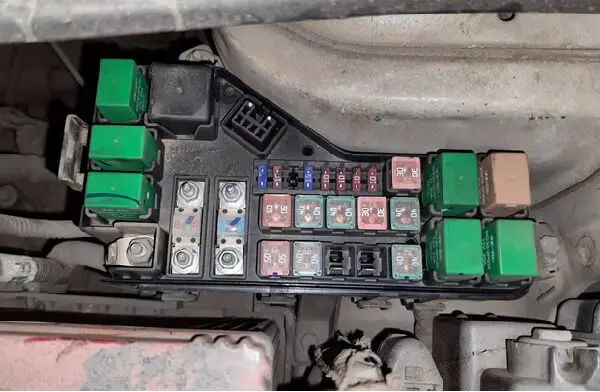Are you facing the issue of the fuel pump not getting power in your Toyota pickup and suspecting a faulty fuel pump relay as the root cause of the vehicle not starting issue? Then you are in the right place! Stay tuned!
The fuel pump is connected to the battery through a series of components like the EFI main fuse, ignition fuse, ignition switch, EFI main relay, AFM fuel pump contact switch, ECU Start signal, and fuel pump relay.
The Toyota pickup fuel pump relay is typically located behind the dashboard on the passenger’s side of the vehicle on the right side of the glove box. Sometimes it is located behind and above the passenger kick panel side and modern Toyota pickups have the fuel pump relay in a total integrated power module box under the hood.
If you have issues with the Toyota pickup fuel pump relay and are interested to troubleshoot and fix the problem. Then, here you will get everything you need to know. Stay tuned!
Table Of Contents
How Does The Fuel Pump Relay Work In Toyota Pickup?
The EFI main fuse receives power from the battery and sends it to the main EFI relay which has got 4 pins. The pins are connected to the ignition switch and ground terminals on the control side and battery and fuel pump relay terminals on the load side.
Whenever someone turns ON the ignition switch, the main relay receives an input voltage and energizes the relay coils, and activates or closes the internal switch to supply power to the fuel pump relay.
The fuel pump relay also has got 5 pins namely B (Battery), Fp (fuel pump), Fc (fuel check connector), E1 (Ground), and STA (ECU Start signal) whose wires typically have the color black, light blue, green/yellow, white with black strips and black with white stripes respectively.
The fuel pump relay is also connected to the AFM (Air Flow Meter) fuel pump switch so that whenever the airflow is sensed, the fuel pump switch is closed and the Fc circuit is activated.
When the fuel pump relay receives a start signal and power from the ECU, the relay coil is energized which activates the switch so that the switch contact closes the circuit and this supplies power to the fuel pump.
The ECU start signal is received by the fuel pump relay to ensure fuel pump priming so that the fuel pump runs for 3 seconds which would ensure that there is fuel pressure on the back of fuel injectors and the vehicle would be ready for firing when cranked without any delay.
After 3 seconds, the ECU start signal to the fuel pump relay is cut off, unless the ECU receives a crank sensor signal indicating that the vehicle is cranked.
Where Is The Toyota Pickup Fuel Pump Relay Location?
To replace the fuel pump relay, it is necessary to know the Toyota pickup fuel pump relay location. Toyota calls the fuel pump relay the circuit-opening relay.
Depending upon the Toyota pickup model year, the fuel pump relay is located at different locations
- In the 1994 Toyota pickup, the fuel pump relay is located behind the right side of the dashboard on the passenger’s right side of the vehicle, and behind the right of the glove box above the ECU. If you remove the glove box, you will find it just to the right of where the glove box should be located. Located on the right of the blower.
- In some models it is also located behind and above the passenger kick panel. Pull the speaker cover and remove the speaker and you should be able to locate it.
- In earlier EFI trucks the fuel pump relays are located individually but later models had a total integrated power control module box (TIPM) located on the passenger side of the engine bay, near the fuse box under the hood that has several other relays and fuses located at a single place.
People often confuse EFI main relay with the fuel pump relay. But it is essential to note that the main relay is different from the fuel pump relay.
Both serve different purposes and it is worthwhile to note that in Toyota pickup EFI main relay is located on the driver’s left side kick panel on the left of the relay panel above the fuse block.
People often suspect the EFI fuse or main relay as the root cause for a vehicle not starting or the fuel pump not getting power.
If the EFI fuse or main relay is faulty, then the engine not cranking or the vehicle not starting becomes a secondary issue, since the vehicle would be dead in the event of a bad main relay.
When Should You Replace The Fuel Pump Relay?
In case, if you have a Toyota truck that has a TIPM box that typically has several relays and fuses and is confused about which one is the fuel pump relay then you may simply view the TIPM box cover from inside where you can read the relay number and its location.
If you suspect that the fuel pump relay is faulty then to confirm the same, you may just swap the fuel pump relay with any other adjacent relays of the same ampere rating and test whether the fuel pump comes alive and the vehicle starting issue vanishes.
If the swapping works then the fuel pump relay is the culprit and needs to be replaced with a new one. If the vehicle starting issue persists then it is not a fuel pump relay problem.
You may need to troubleshoot the fuel system parts like the fuel pump and its strainer, fuel filter, fuel pressure regulator, wiring harness, or electrical connections.
Can you hear the humming sound from the fuel pump as it primes when you turn on your ignition key? If yes, then the fuel pump may not be delivering the fuel pump at the required pressure and flow rate. It is recommended to check the fuel pressure at the delivery hose to the engine.
If there is no humming sound then probably the fuel pump is not priming, so either the fuel pump is not getting power or it is dead and need to be replaced with a new one.
Sometimes the car won’t start even after fuel pump replacement and that may need an entirely different perspective for troubleshooting.
Typically, if there is a break in the electrical wiring harnesses or a bad electrical connector then the fuel pump won’t get a power supply for its operation.
You need to troubleshoot the wiring harness by testing the voltage at various points between the fuses, relays, connectors, and fuel pump and use the method of elimination to pinpoint the issue area.
Often if the fuel pump is failing then the fuel pump fuse keeps blowing and people come to know about this after repeated events.
How To Bypass The Fuel Pump Relay? A Temporary Solution!
After troubleshooting, if you identify that the fuel pump relay is the problem and you do not have a replacement relay then as a temporary fix, you may directly use a jumper cable between the battery (B) and fuel pump (Fp) pins.
Typically, the fuel pump relay winding coils malfunction and fails to close the switch contact, but by using a jumper wire you would bypass the fuel pump relay and its reliance on ECU start and AFM signals which energizes the relay coils to allow the fuel pump to receive power supply from the battery.
But it is recommended to replace the fuel pump relay once you get fresh replacement parts and disconnect the jumper cable at the earliest possible time as it defeats a safety feature built into the system.
In the presence of a fuel pump relay, if the engine stops running then the fuel pump will do so. But if you have used the jumper wires, irrespective of whether the engine is running or not, the fuel pump would run continuously with the key ON position.
This will affect the durability and life of the fuel pump since it would run whenever you put the key in ignition ON mode and the problem will be more severe if you run out of fuel in the tank since the pump would run dry and needs fuel for cooling and lubrication to perform effectively. Otherwise, the fuel pump would fail prematurely.
One more hazardous problem could be that in the event of an accident, if the fuel hose gets damaged, then since the fuel pump would run continuously, it would keep on delivering fuel to the broken supply line and that leads to fire hazards.
Final Thoughts
The Toyota pickup fuel pump relay is typically located either behind the glove box on the passenger’s right side or above the passenger side kick panel.
Before you replace the fuel pump relay it is necessary to confirm that the culprit is the fuel pump relay. Otherwise, even after replacing it, the vehicle would not start.
If you understand when to replace the fuel pump relay as mentioned in this article you would be able to pinpoint the pain area with ease and save time and bucks in replacing one part after another.
Happy Motoring!

